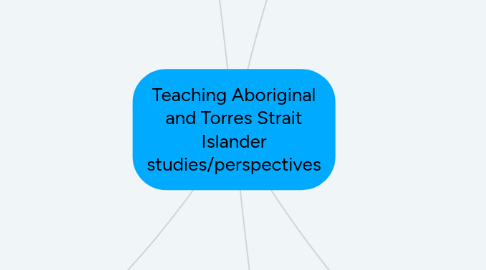
1. Cross Curriculum Priority: Aboriginal and Torres Strait Islander histories and culture
1.1. Maths
1.1.1. Link in through Measurement when cooking bush tucker.
1.1.1.1. Connectedness
1.1.1.2. Learning outside classroom walls
1.2. History
1.2.1. Content descriptor: Examine different viewpoints on actions, events, issues and phenomena in the past and present (ACHASS1099)
1.2.2. Year level: 5
1.2.3. Outcomes: By the end of this unit of work, students will be able to analyse different sources to identify and understand different motives and experiences of individual and groups involved in past or present events and issues.
1.2.3.1. Recognition
1.2.3.2. Respect
1.2.3.3. Understanding
1.2.4. Resources: Different sources of information on Aboriginal and Torres Strait Islander histories. Power point on information about histories and culture. Elder to tell stories on histories.
1.2.5. Assessment: I will assess my students through a marking rubric.
1.3. Art
1.3.1. Year level: 5
1.3.2. Content descriptor: Explore ideas and practices of Aboriginal and Torres Strait Islander artists, to represent different views, beliefs and opinions (ACAVAM114)
1.3.3. Outcomes: By the end of this unit of work, students will be able to select and manipulate combinations of materials and techniques
1.3.3.1. Culturally responsive
1.3.3.2. Exploring culture
1.3.4. Resources: Various art materials and paints . Information of practices of Aboriginal and Torres Strait Islander artists through power point presentation
1.3.5. Assessment: Checklist, Observations
1.4. English
1.4.1. Languages
1.4.2. Storytelling
1.4.2.1. Respect
1.4.2.2. Cultural interface
1.4.3. Elder Contribution
1.4.3.1. Relationships
1.4.3.2. Respect
1.5. HPE
1.5.1. AFL links: Learning about Aboriginal and Torres Strait Islanders who have successful sport careers
1.5.1.1. Recognition
1.5.1.2. Relationships
1.5.1.3. Acknowledgement
1.6. Music
1.6.1. Year level: 5
1.6.2. Content descriptor: Explain how the elements of music communicate meaning by comparing music from different social, cultural and historical contexts, including Aboriginal and Torres Strait Islander music. (ACAMUR091)
1.6.3. Outcome: By the end of this unit of work, students will be able to participate in and responding to music from a variety of contexts and cultures as both audience members and performers.
1.6.3.1. Respect
1.6.3.2. Culturally responsive
1.6.3.3. Acknowledgement
1.6.3.4. Exploring culture
1.6.4. Resources: Example pieces of Aboriginal and Torres Strait Islander music. Musical instruments.
1.6.5. Assessment: Through observations and checklists
2. Teaching Rationale
2.1. Communication
2.2. Relationships
2.3. True Historical
2.4. Creativity
2.5. Identity
2.6. Self reflections
2.7. Reconciliation
2.8. Social Justice
2.9. Listening
2.10. Culturally responsive
2.11. Recognition
2.12. Reconstruct/Deconstruct
2.13. Self actualisation
2.14. Belonging
2.15. Compassion
2.16. Understanding
2.17. Respect
2.18. Connectedness
3. AITSL Standards
3.1. AITSL Standard 1.4 Strategies for teaching Aboriginal and Torres Strait Islander students
3.1.1. Broad knowledge and understanding of the impact of culture, cultural identity and linguistic background on the education of students from Aboriginal and Torres Strait Islander backgrounds.
3.1.1.1. Recognition
3.1.1.1.1. Of past and present
3.1.1.2. 3 R's: Responsibility, Relationships, Respect
3.1.1.2.1. Forming trust
3.1.1.3. Cultural Interface
3.1.1.3.1. The space or “Gap” between Indigenous and non-Indigenous peoples knowledge.
3.1.1.4. Red dirt pedagogy
3.1.1.4.1. Advocacy to promote equal opportunities and approaches in research and education.
3.1.1.5. Culture: Cultural identity/ Language
3.1.1.5.1. On Country Learning: An intensive course with the objective to teach Australian history through an Aboriginal perspective. They use Yorta Yorta as the case study. The classroom has no walls and is on the Yorta Yorta country land
3.1.1.6. Storytelling
3.1.1.6.1. Respect
3.1.1.6.2. Recognition
3.1.1.6.3. Understanding
3.1.1.7. 8 Ways of learning: Tyson Yunkaporta
3.1.1.7.1. • Story sharing • Learning map • Non-verbal • Symbols and images • Land links • Non-linear • Deconstruct/reconstruct • Community links
3.1.1.8. Two way learning
3.1.1.9. Have high expectations of your students
3.1.1.9.1. Strong and Smart: Changing low expectations of Indigenous student to have high expectations. This will increase achievement, encourage and empower our Indigenous students through helping them to have a positive sense of cultural identity.
3.1.1.10. Acknowledgement and incorporation of Key Indigenous Australian events into teaching – celebrations, ceremonies, festivals, concerts and symbols
3.1.1.10.1. -Australia Day – Invasion Day or Survival Day -Anniversary of the National Apology -Anniversary of the signing of the Close the Gap Statement of Intent on Indigenous Health Equality -National Close the Gap on Indigenous Health Equality Day -National Sorry Day -National Reconciliation Week -Commemorating Aboriginal and Torres Strait Islander war veterans -Mabo Day -National NAIDOC Week -National Aboriginal and Islander Children’s Day -International Day of the World’s Indigenous People -The Deadly Awards -Literacy Day
3.2. AITSL Standard 2.4 Understand and respect Aboriginal and Torres Strait Islander people to promote reconciliation between Indigenous and non-Indigenous Australians
3.2.1. Understanding of and respect for Aboriginal and Torres Strait Islander histories, cultures and languages.
3.2.1.1. People
3.2.1.1.1. Responsibility, Respect, Relationships, Recognition
3.2.1.2. Cultures
3.2.1.3. Histories
3.2.1.3.1. Anzac Day
3.2.1.3.2. Past Policies
4. Early Years Learning Framework
4.1. Belonging, being, becoming
4.1.1. Children have a strong sense of identity
4.1.1.1. Children feel safe, secure, and important
4.1.2. Children are connected with and contribute to the world
4.1.2.1. Children develop a strong sense of belonging to groups and communities and an understanding of the reciprocal rights and responsibilities necessary for active community participation

